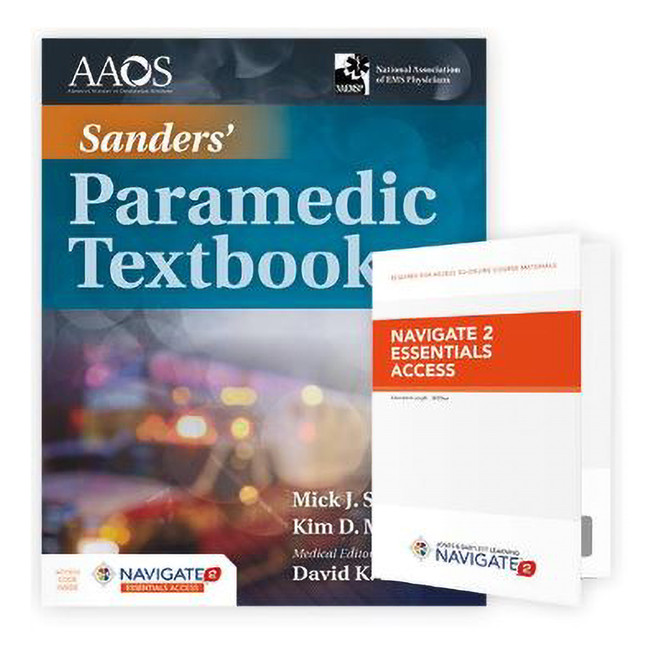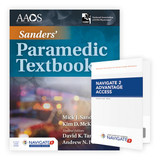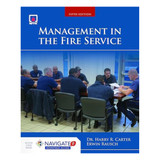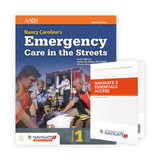Sanders' Paramedic Textbook, 5th Edition Includes Navigate 2 Essentials Access
Navigate 2 Essentials Access unlocks a complete audio book, Assessment Center, and dashboard that reports actionable data.
Sanders' Paramedic Textbook, Fifth Edition integrates authoritative content that elicits higher-order thinking, preparing students to thrive as members of a sophisticated health care team. Published in conjunction with the American Academy of Orthopaedic Surgeons (AAOS) and the National Association of EMS Physicians (NAEMSP), this edition offers material that aligns with the most current guidelines, standards, and medical research in the field of EMS.
The Fifth Edition, based on the National EMS Education Standards, the 2015 CPR/ECC Guidelines, and the 2017 Neonatal Resuscitation Program, presents evidence-based medical concepts in a clear and comprehensive format. Detailed coverage of essential skills enables students to meet and exceed the National Registry Paramedic Psychomotor Competency Portfolio.
Robust resources for educators and students deliver teaching and learning solutions that create a premier learning experience—engaged, meaningful learning that applies to the real world of EMS.
Key Features and Content Updates:
- Over 1,000 new photos and illustrations
- Current information on spinal immobilization from evidence-based research and national physician organizations
- Expanded content coverage for all patient groups, including pediatric and geriatric patients and special populations
- Increased coverage of pathophysiology, 12-lead ECG interpretation, mechanical ventilation, ultrasonography, and many other critical topics
- New Show Me the Evidence and Critical Thinking features that challenge students and highlight notable, current content
- Updated Did You Know? material that extends learning beyond the basics
- Emphasis on research and the paramedic's role in injury prevention
- Updated Emergency Drug Index and Advanced Practice Procedures for Critical Care Paramedics
Table of Contents
- Section 1 Preparatory
- Chapter 1 EMS Systems: Roles, Responsibilities, and Professionalism
- Chapter 2 Well-Being of the Paramedic
- Chapter 3 Injury Prevention, Health Promotion, and Public Health
- Chapter 4 Documentation
- Chapter 5 EMS Communications
- Chapter 6 Medical and Legal Issues
- Chapter 7 Ethics
- Chapter 8 Research Principles and Evidence-Based Practice
- Section 2 Anatomy and Physiology
- Chapter 9 Medical Terminology
- Chapter 10 Review of Human Systems
- Chapter 11 General Principles of Pathophysiology
- Chapter 12 Life Span Development
- Section 3 Pharmacology
- Chapter 13 Principles of Pharmacology and Emergency Medications
- Chapter 14 Medication Administration
- Section 4 Airway
- Chapter 15 Airway Management, Respiration, and Artificial Ventilation
- Section 5 Patient Assessment
- Chapter 16 Therapeutic Communications
- Chapter 17 History Taking
- Chapter 18 Scene Size-up and Primary Assessment
- Chapter 19 Secondary Assessment and Reassessment
- Chapter 20 Assessment-Based Management and Clinical Decision Making
- Section 6 Cardiovascular
- Chapter 21 Cardiology
- Section 7 Medical
- Chapter 22 Diseases of the Eyes, Ears, Nose, and Throat
- Chapter 23 Respiratory
- Chapter 24 Neurology
- Chapter 25 Endocrinology
- Chapter 26 Immune System Disorders
- Chapter 27 Infectious and Communicable Diseases
- Chapter 28 Abdominal and Gastrointestinal Disorders
- Chapter 29 Genitourinary and Renal Disorders
- Chapter 30 Gynecology
- Chapter 31 Hematology
- Chapter 32 Nontraumatic Musculoskeletal Disorders
- Chapter 33 Toxicology
- Chapter 34 Behavioral and Psychiatric Disorders
- Section 8 Shock and Resuscitation
- Chapter 35 Shock
- Section 9 Trauma
- Chapter 36 Trauma Overview and Mechanism of Injury
- Chapter 37 Bleeding and Soft-Tissue Trauma
- Chapter 38 Burns
- Chapter 39 Head, Face, and Neck Trauma
- Chapter 40 Spine and Nervous System Trauma
- Chapter 41 Chest Trauma
- Chapter 42 Abdominal Trauma
- Chapter 43 Orthopaedic Trauma
- Chapter 44 Environmental Conditions
- Section 10 Special Patient Populations
- Chapter 45 Obstetrics
- Chapter 46 Neonatal Care
- Chapter 47 Pediatrics
- Chapter 48 Geriatrics
- Chapter 49 Abuse and Neglect
- Chapter 50 Patients With Special Challenges
- Chapter 51 Acute Interventions for Home Care
- Section 11 EMS Operations
- Chapter 52 Ground and Air Ambulance Operations
- Chapter 53 Medical Incident Command
- Chapter 54 Rescue Awareness and Operations
- Chapter 55 Crime Scene Awareness
- Chapter 56 Hazardous Materials Awareness
- Chapter 57 Bioterrorism and Weapons of Mass Destruction
- Appendix Emergency Drug Index
- Appendix Advanced Practice Procedures for Critical Care Paramedics
© 2019, Pages: 2146, Hardcover













